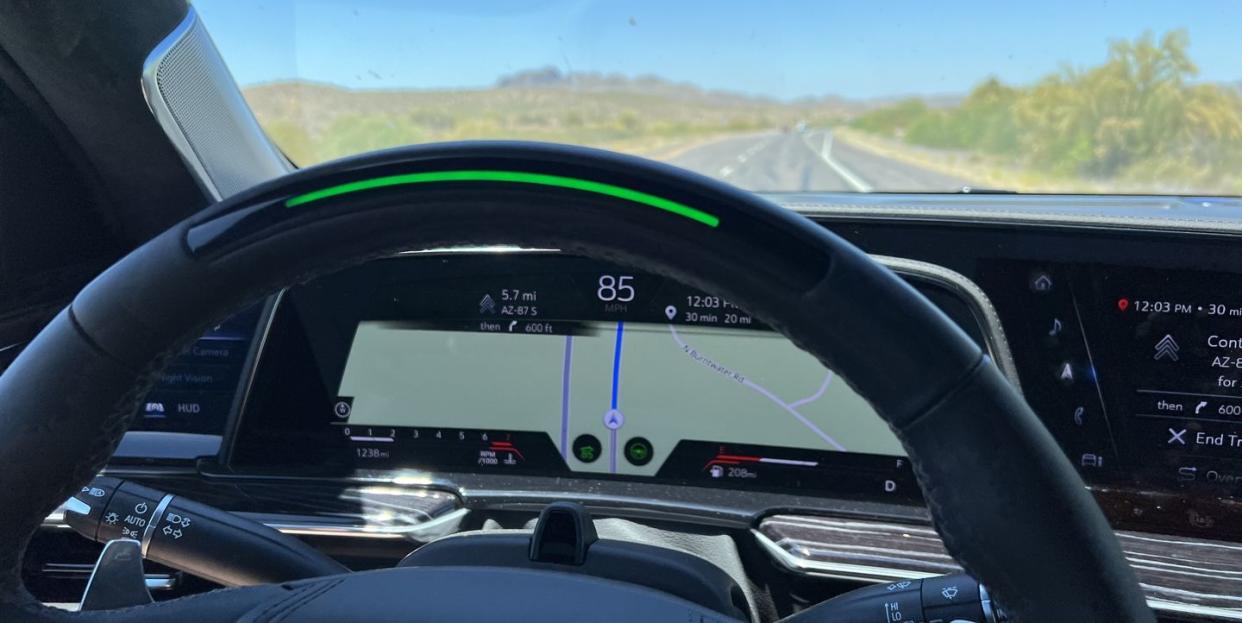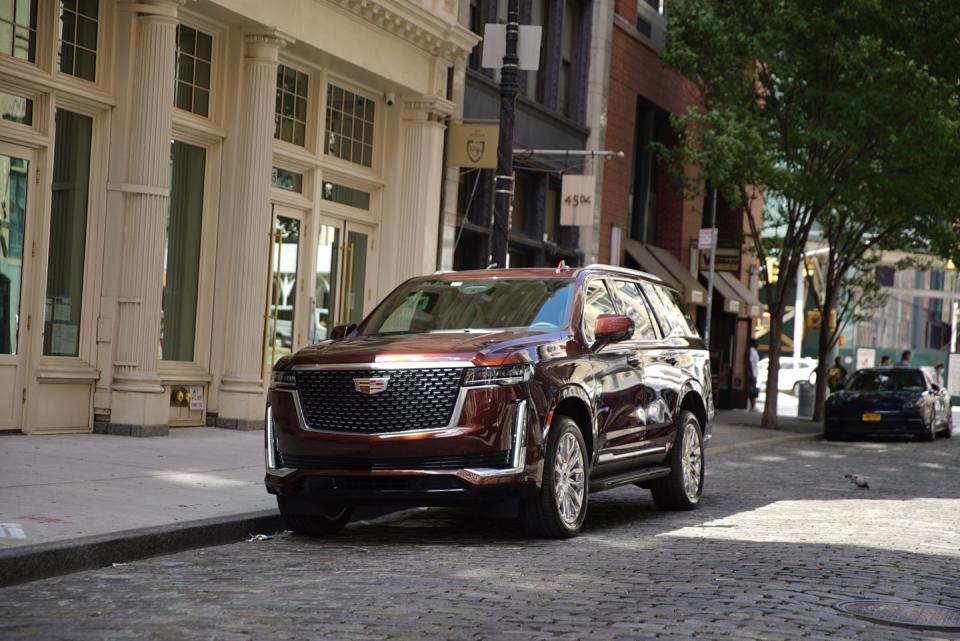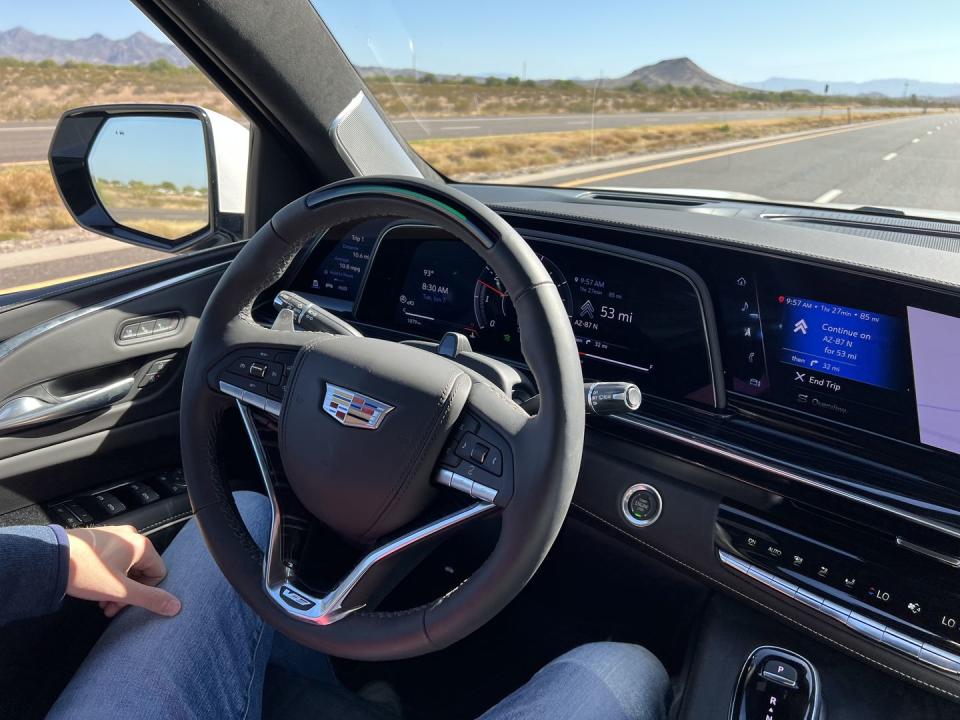The Newest Version of Cadillac’s Super Cruise Is Actually Great

This past weekend, I went on a trip from New York to eastern Connecticut to visit a friend for his birthday. I spent roughly seven hours in the driver’s seat over 300 miles, yet I barely touched the steering wheel. That’s because the car I was driving was equipped with Cadillac’s Super Cruise.
Super Cruise is a fancy brand name for Cadillac’s hands-free driver assistance system. When activated, it’ll control the throttle, brakes, and steering without any input from the driver. And unlike most driver assistance systems I’ve experienced, it’s actually something you’d want to use on a regular basis.

The system has been around for years now. First announced in 2014 and launched in 2017 on the CT6 sedan, it uses pre-scanned LIDAR map data, real-time GPS tracking, and a slew of car-mounted cameras and sensors to operate. Its first iteration worked well, but didn’t stand out as something you’d actually want to use all the time. But this latest update, pushed out in 2020, is a game-changer. Enhancements to the programming mean more natural steering and pedal inputs, while automatic lane-changing means you don’t have to intervene when you come upon a slower car on the road. And activating it is as easy as pushing one button on the steering wheel while cruise control is active.
On the road, it’s uncanny just how well Super Cruise works. It’s not just that it’ll stay between the lines and not hit anything—that’s the bare minimum these days. It’s that the system just seems so natural. It feels like there’s an actual human driving the car, rather than a machine designed to mimic a driver. It’ll speed up and slow down in traffic without being jerky, and lift off through sharper bends so as not to throw occupants about the cabin. With Super Cruise, there isn’t this constant fear that you’re inconveniencing other drivers on the road or getting in their way. It blends in perfectly to the environment in which it’s operating.
Most impressive is Super Cruise’s ability to analyze the road situation and change lanes accordingly. The system will speed up or slow down to automatically switch lanes, just like a real driver would. Even if you activate Super Cruise while in the left lane, it’ll eventually make its way to the right lane to let quicker traffic go by. If a particularly strong gust of wind catches the car, it’ll apply corrective steering to bring itself back to the center of the lane. This was especially helpful considering the car used for this test was a 2022 Escalade, a vehicle with the side profile of a building. Super Cruise will even work when it’s raining.
Best of all, Super Cruise lacks the hesitation found in so many other driver assistance systems that make them unbearable to use. It’s refreshing not having to worry about Super Cruise’s every move—it just does what it’s expected to without being intrusive.

You still have to keep your eyes on the road, of course. There are monitoring systems inside the cabin to ensure the driver never stops paying attention to what’s in front of them. If you look down at your phone or stare at your mirrors for too long, the bright green strip of light on the steering wheel will begin to flash to get your attention. Keep your eyes away for too long, and the system will turn off and bring the car safely to a stop. This isn’t a self-driving system—it’s important to make that distinction. On the plus side, Super Cruise can monitor your eyes through sunglasses, so you don’t have to take them off to get the system to work.
Super Cruise is far from perfect, obviously. It stopped working—after sufficient warning—several times while on I-95, a road pre-scanned by the system, citing “no road information.” There were also a couple of instances where it wouldn’t activate because it thought the car was in an exit lane when it was just cruising in the right-most lane. There were a few sections of road I wasn’t totally comfortable letting Super Cruise drive on, like tight construction zones (Cadillac says not to use it here) or Manhattan’s no-runoff, wild-west FDR Drive. It’s not that it wouldn’t navigate through these places, it’s just that the margins are too close to take the risk.

While having the LIDAR data makes Super Cruise work as well as it does, it also limits the system’s use. Cadillac has mapped over 200,000 miles of highway in North America, covering a vast majority of our country’s well-used interstate system. The problem is, there are over 4 million miles of road in the United States. So if you don’t drive on one of those pre-mapped roads, Super Cruise is useless to you.
There’s also the price. Adding Super Cruise to your Cadillac will cost you $2500 upfront, along with an active subscription to keep it working. The first three years are included with the purchase price, but after that, you’ll have to shell out $25 a month, according to Onstar’s website.

Super Cruise makes the monotonous boredom of highway driving just a bit more relaxing. Sure, you still have to pay attention. But you’re not constantly applying micro-movements to the car to stay in your lane or pass slower traffic. You’re just sitting there, chilling out, listening to your favorite podcast. It’s not a massive improvement, it’s just something that makes the ins and outs of everyday life slightly more bearable.
Whether that’s worth the price of entry and the monthly premium is up to the driver. To me, it only seems worth it if you're commuting on a Super Cruise-mapped road every day. And even then, it’d have to be a long enough drive to keep Super Cruise enabled for more than a few minutes at a time. Otherwise, it just becomes a gimmick to show off to friends and family a few times a year. But as the system gets better, it’ll begin to appeal to more and more people. Seeing how far GM has come so far, we have high hopes for the future of Super Cruise.
You Might Also Like

